 Gilman Studio On-Line Lessons
Gilman Studio On-Line Lessons
Yang Style Long Form
Tai Chi Chuan
This Lesson Contains:
Movement # 66 – Single Whip
Here is our old friend Single Whip once again. I particularly like this double opponent application. It feels good to do and is very useful in a martial sense. The first opponent attacks with his left fist. I neutralize by joining, sticking, and leading with my hooked right hand. I follow with a strike with my right wrist. The second opponent threatens from the left with his right fist. I evade, and deliver three strikes in rapid succession.
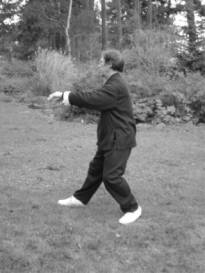
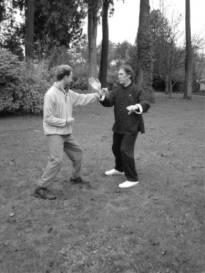 The first picture is a transition movement in the form. The second shows the joining with the incoming strike.
The first picture is a transition movement in the form. The second shows the joining with the incoming strike.
Shift the weight back onto the left foot. Let the two arms relax until they are parallel to the ground. Keep the elbows and shoulders relaxed.
Next, turn the torso to the left until it faces north. At the same time allow the right hip to turn left and pivot the right foot to end with the toe facing north.
The two arms move to the left with the torso. The right palm turns to face to the left. At this point, my right wrist comes in contact with Yoshi’s wrist.
Focus on the right wrist.

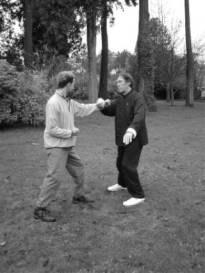 My right hand forms the hook over Yoshi’s wrist.
My right hand forms the hook over Yoshi’s wrist.
At this point, allow the right hand to form the hook by bending at the wrist and joining all the fingers together, like you were holding something breakable between your fingers.
There are no other body movements.
Focus on the right hand to form the hook and stick to opponent’s wrist.
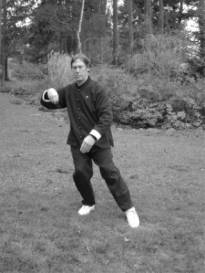
 I am leading the opponent’s strike into emptiness.
I am leading the opponent’s strike into emptiness.
Shift the weight onto the right foot. The torso turns slightly to the right in order to lead the strike to the right, and to store energy in the right Kua.
The right hand hook moves back towards the right armpit as the body moves back. Keep the elbow drooped. The left arm drops down in front of the crotch to protect. It is relaxed with the palm facing inward.
Focus on the right hand to lead.
Note: I am just following the incoming energy of the opponent’s strike. My hook hand sticks and leads the opponent further then he wanted. You can see Yoshi is now out of his root, leaning forward.
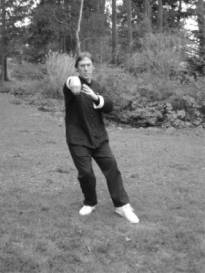
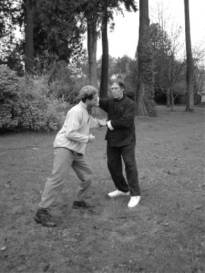 I strike the side of Yoshi’s face with the wrist.
I strike the side of Yoshi’s face with the wrist.
Keeping the weight on the right foot, pivot the waist to the left, sending out the right arm. If I meant this strike to do damage, I would use Fa Jing by quickly doing a twisting like motion with my waist to send the right arm outward. The energy comes from the stored energy in my right Kua. It is a whipping like motion. In the form, just turn the waist to the left until it faces north. Relax onto the left toe.
The left arm circles up to end by the right elbow. It can protect the elbow, or as shown here, hold onto the opponent’s hand so the strike with the right wrist will be more effective.
Focus on the right wrist.
Note: A strike with the wrist seems tricky and you must be careful to hit with the end of the forearm bones, not the hand.
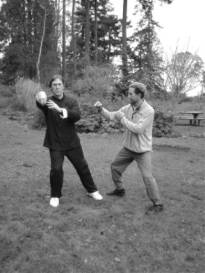 The second opponent approaches from the left side.
The second opponent approaches from the left side.
In the form, there is no distinction between these two parts of the same movement. If someone did not know the applications of the Tai chi form, they would see just one continuous movement from start to finish.

 I evade and strike to Yoshi’s lower body.
I evade and strike to Yoshi’s lower body.
Sink the weight deeper into the right foot. Turn the torso to the left and step out with the left heel to face west. Be sure to step far enough to the left to provide a stable base of support.
The right hand remains in the hook. The left arm drops and moves with the body to the left. The wrist is leading the arm movement.
Focus on the left wrist.
Note: In this application picture, I am sinking the weight some to get under Yoshi’s guard. In the form, I remain at the same level as before. The strike with the back of my left wrist could go to the crotch or lower belly.
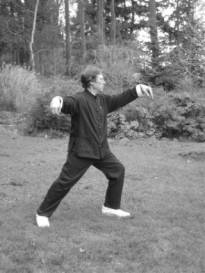
 I continue the upward strike with the back of my left wrist. This time to Yoshi’s chin.
I continue the upward strike with the back of my left wrist. This time to Yoshi’s chin.
Shift the weight onto the left foot and turn the torso until it faces west.
The left wrist continues to rise until it is level with your chin. It is on the left center side of your body.
The right hand remains in the same place.
Focus on the left wrist.

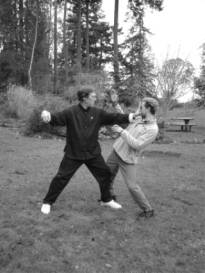 The third strike is a downward force with the left palm.
The third strike is a downward force with the left palm.
The body remains in the same place.
The left wrist “sits”. The palm faces outward. This is accomplished by an internal dropping of the energy. Keep the elbow and shoulder drooped. The right arm remains in the same place.
Focus on the left palm.
Note: Maintaining the right arm in the hook hand while doing all the striking with the left hand might seem strange. Not only does it look good for the form, there is an internal balance of energy by maintaining this openness with the two arms.
